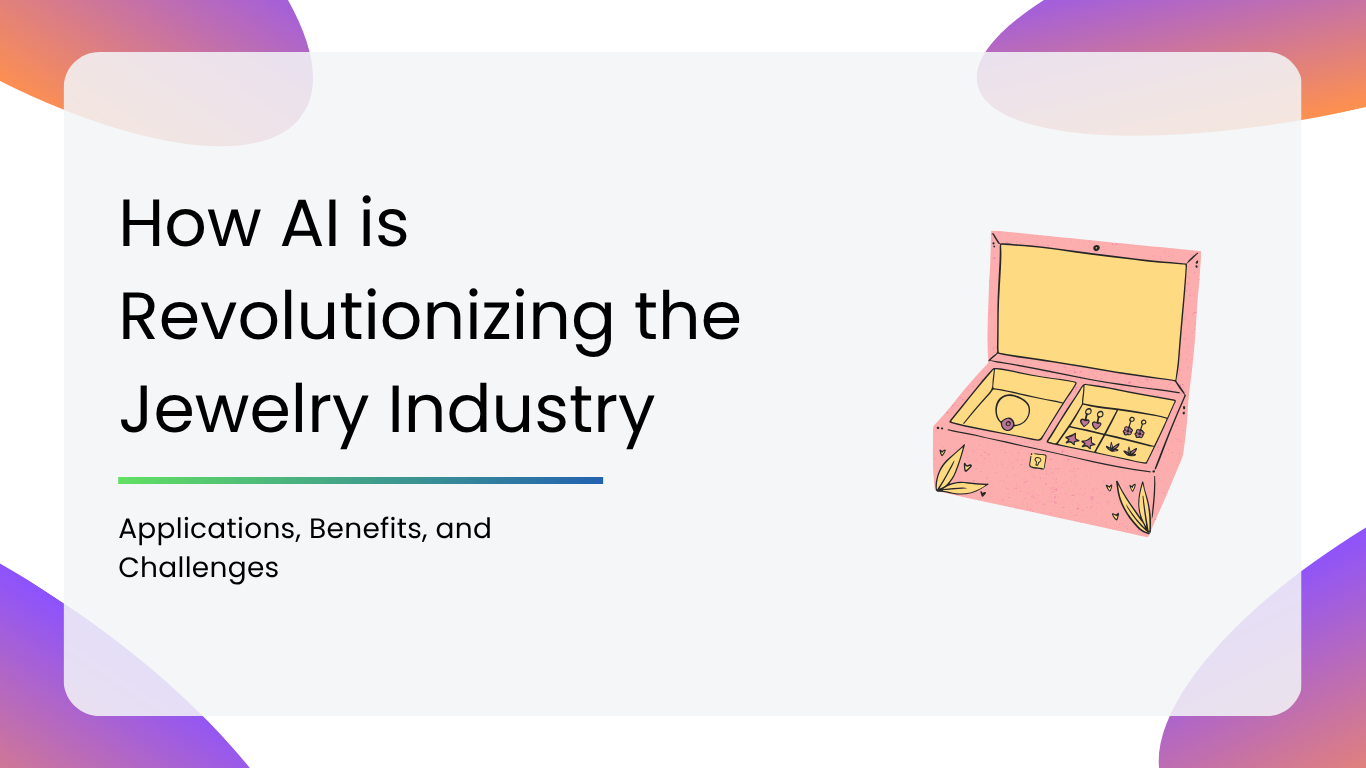AI is everywhere these days. From the content that you watch on Netflix to the ads that follow you around online. AI is shaping more of our world than we even realize. But jewelry? That seems like an unlikely place for AI to step in, right?
We usually associate jewelry with handcrafted precision, legacy, and timeless beauty. Not algorithms. But surprise, AI is quietly revolutionizing this age-old industry as well. Wanna know how? Let’s break it down.
The Role of AI in Jewelry Industry
For decades, the jewelry industry has relied on hand-drawn sketches and artisan expertise to create every intricate design. The process was slow, yes, but deeply rooted in craft and time-intensive techniques. But as consumer demand started to shift, so is the need for faster timelines, personalized designs, and digital shopping.
Today AI has transformed how jewelry is designed, produced, and even sold. Tools like generative design algorithms can take a rough idea or mood board and spit out hundreds of refined design options. What sometimes took days or even weeks, can now happen in an hour.
Jewelers can now simulate how different metals or stones will look together, without wasting a single material. AI-integrated machines can now track precision cuts, reduce material waste, and even predict production errors before they happen. So, AI isn’t just making things faster, it’s making things smarter. Machine learning can identify and analyze trends, picking up traction in real time by analyzing data from trending platforms like Instagram, Pinterest, and e-commerce platforms.
Designers aren’t being replaced, rather, they’re being pushed to focus on what they do best: storytelling through design.
Benefits of AI-Driven Innovation in Jewelry Industry
Let’s explore the benefits that AI brings to the jewelry industry:
- Higher Efficiency: Before AI, a design team would go through multiple drafts, wait on feedback loops, and sometimes rework entire pieces after client reviews. Now, tools powered by AI can take an initial brief and auto-generate multiple versions instantly. Also, production timelines have become way shorter.
- Next-Level Customization: From scanning customer preferences and browsing habits to suggesting designs tailored to their taste, AI makes it possible to deliver a one-of-a-kind experience. It’ll spot the pattern from their behavior and help designers deliver just that!
- High Cost Savings: Fewer errors in design, minimal material wastage, predictive supply planning… all these things directly impact the bottom line. Let AI take over the guesswork with less trial-and-error, more targeted production, fewer returns, and better margins.
Key Applications of AI in Jewelry Industry
Here are some real-life applications of AI and the role it plays in the jewelry industry:
- AI in Jewelry Design & Prototyping: Designs can just plug in a few inputs like gemstone choice, budget, the style vibe, and boom, AI creates several design options. The software can literally imagine fresh patterns and structures based on past data and aesthetic trends.
- AI in Jewelry Manufacturing: AI optimizes every stage, from cutting and setting to final polishing. There are even AI-driven 3D printers now that adapt to the printing process in real-time, based on material density and structural load.
- AI in Customer Experience & Personalization: From helping you pick the right ring to virtual try-ons that use facial recognition or hand mapping, the experience is all about deep personalization.
- AI in Jewelry Marketing & E-Commerce: AI tracks user behaviour, learns preferences, and then serves us jewelry suggestions that match individual tastes. AI also helps in dynamic pricing, inventory control, and even forecasting trends based on social media activity.
- AI in Authentication & Fraud Detection: AI can analyze microscopic details like cut angles, engraving patterns, or even light reflection to verify if a piece is real or not. Every step of the supply chain also gets tracked and verified, building trust.
Challenges of AI in Jewelry Industry
Like every other industry, AI here too comes with its own set of challenges.
- Cost of AI Implementation for Small Businesses: AI isn’t cheap. The initial setup, the training, the software, and hardware… it adds up real fast. Small businesses can struggle with this initial cost.
- Balancing Automation with Human Craftsmanship: Automation is cool, but how do you balance the precision and speed of AI with the soul of handcrafted pieces? Human touch can be hard to evoke.
- Consumer Trust in AI-Generated Designs vs. Handcrafted Jewelry: Some consumers just won’t warm up to the idea of a computer-generated design, no matter how perfect it is. It’s hard for some to believe a machine can truly feel the artistry, the meaning behind a piece.
Future of AI in Jewelry Industry
The jewelry industry is just scratching the surface when it comes to what AI can do. As technology evolves, the future promises innovations we haven’t even imagined yet. From redefining the design process to transforming how consumers shop, AI is slowly becoming the silent partner behind the sparkle.
Emerging Trends in AI-Driven Jewelry Innovation
AI’s influence on the jewelry industry isn’t slowing down anytime soon. In fact, it’s evolving at a surprising rate. From smart jewelry that tracks health metrics to AI-assisted design tools that predict the next big trend, the future is exciting.
If you thought AI was just another passing trend, well… buckle up because it’s about to get even more wild. Designers are already working with AI to create innovative styles that are not just futuristic but also reflect a level of personalization like never before. The future? AI might help predict trends before they even hit the market!
Beyond design, AI is transforming the supply chain by optimizing inventory management, forecasting demand, and even tracking gemstone authenticity using machine learning. AI chatbots and recommendation engines are making jewelry shopping more interactive and tailored than before. Virtual try-on experiences are also leveling up, allowing customers to see how a piece looks in real time, with precision and accuracy.
AI’s Potential to Create Fully Automated Jewelry Brands
Imagine a jewelry brand that doesn’t need human designers. AI could literally design, manufacture, and sell jewelry autonomously. So, thinking of having no more human designers? Could be a possibility.
With AI handling everything from designs to market analysis, it could totally streamline production, reducing costs and time for brands. The next step might just be AI-driven jewelry brands where everything from concept to consumer behavior is automated.
AI is making huge waves in the jewelry industry, and it’s only going to get bigger from here. Whether it’s creating stunning designs, improving manufacturing processes, or offering personalized shopping experiences, the possibilities are endless.
But, of course, with every opportunity comes challenges. The balance between tradition and technology, as well as consumer trust, will require careful consideration. Now, the question isn’t about whether AI will revolutionize the jewelry industry, it’s about how soon.
Curious about how technology is shaping jewelry design even further? Don’t miss our blog The Best AI Tools For Jewelry Design, where we break down top tools that are helping designers bring creativity and precision together.
Curious about the impact of AI in other spaces? Check out our other blogs:
FAQs
Creativity, emotion, and personal touch are things that can’t be fully replaced. While AI can absolutely assist in design and even create some breathtaking pieces, it’s unlikely to completely replace human designers anytime soon.
With advanced image recognition, AI can quickly detect and identify specific characteristics of gems, like clarity, cut, and color, ensuring they are genuine and not imitation.
By analyzing customer preferences, style history, and even body measurements, AI can recommend custom pieces tailored to the individual, making every piece of jewelry feel unique.
Yes. Small businesses can use AI-powered tools for design, inventory, customer support, and even marketing. It’s all about choosing the right tools for your scale.
Disclosure – This post contains some sponsored links and some affiliate links, and we may earn a commission when you click on the links at no additional cost to you.





